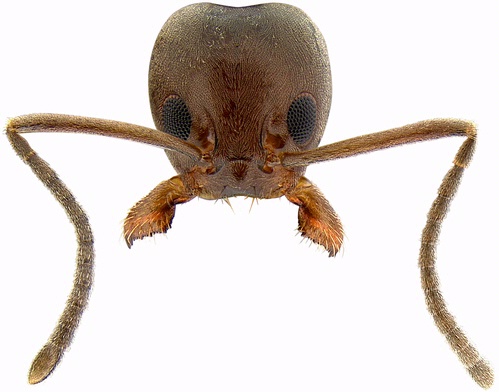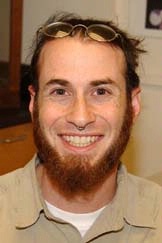- Author: Kathy Keatley Garvey
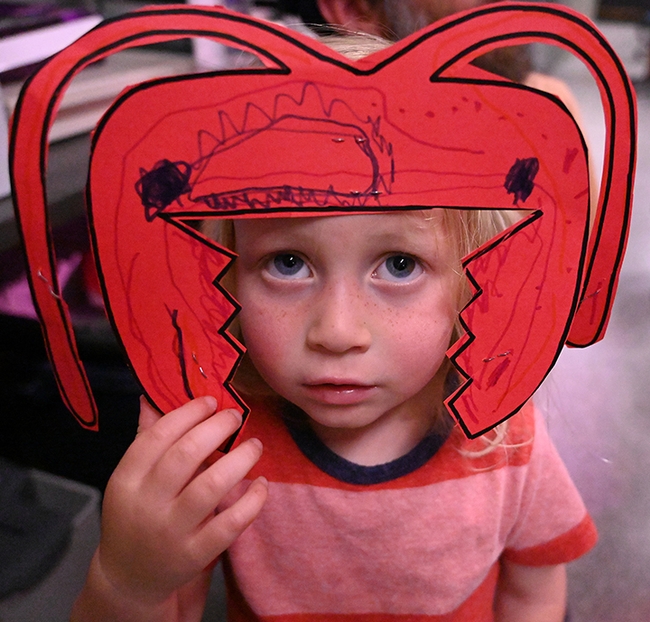
They really weren't red ants, but children wearing ant headgear, created during the family arts-and-crafts activity at the Bohart Museum of Entomology's open house on ants. The Phil Ward lab, UC Davis Department of Entomology and Nematology, organized and presented the open house.
The ant headgear was the brainchild of Tabatha Yang, education and outreach coordinator, and student intern Jakob Jess of MET Sacramento High School. He completed his two-year internship at the Bohart Museum this week, and starting this fall, will begin his studies at UC Berkeley.
"This was an art project inspired by leafcutter ants," Yang said, "and was meant to be both whimsical and colorful, thus the bright red. We had a template for folks to use, but they could also create their own from looking at the ant illustrations."
Myrmecologist Eli Sarnat, who received his doctorate at UC Davis, studying with Professor Ward, brought his sons, Benjamin, 7 and Evan, 3 to the event. They delighted in creating the ant headgear and checking out the ant displays.
UC Davis senior entomology major Morgan Myhre helped her children, Galileo, 5, and Esmeralda, 2, with their creations.
First-year entomology major Kat Taylor staffed the arts-and-crafts table, assisting the youngsters with their ideas. She also stapled the finished projects.
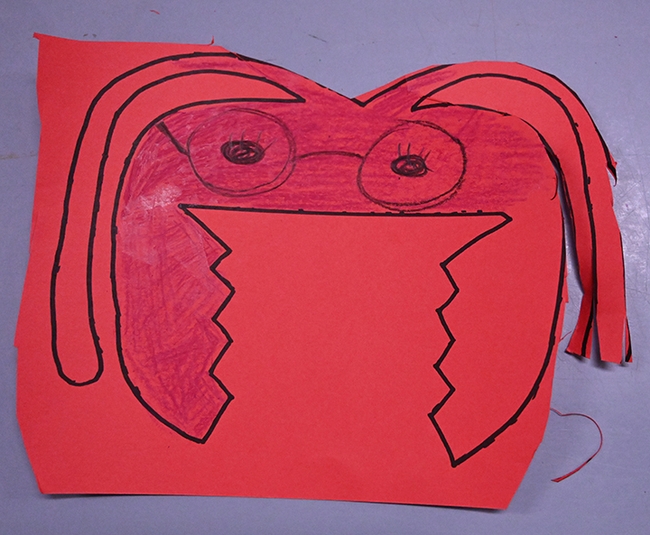
"The questions were mostly about the habits and behavior of ants, how many species are there, etc.," Ward related. "And how can I obtain live colonies for my kid? I received almost no queries about 'how do I get rid of them in my kitchen?' and that was refreshing."
"We had live colonies of a centipede-hunting ant (Stigmatomma oregonense) and a generalist omnivore (Aphaenogaster occidentalis)," Ward said. "The displays also included collections of common California ants; the world's smallest ant (Carebara) and the world's largest ant (Myrmecia)."
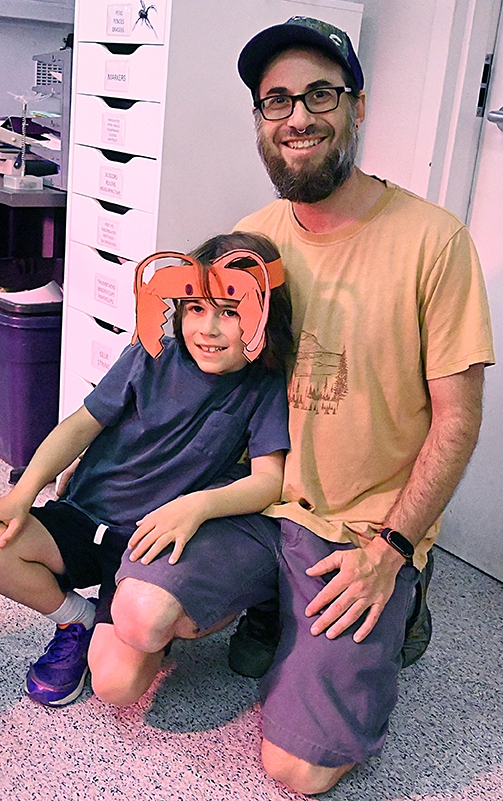
Oberski, who received her bachelor's degree in biology and a bachelor's degree in German studies (summa cum laude) in 2016 from Macalester College, Saint Paul, Minn., finished her dissertation earlier this month. She will present her exit seminar on "Phylogenetics and Biography of Pyramid Ants" at 4:10 p.m., Wednesday, June 7 in 122 Briggs Hall. It also will be on Zoom.
Oberski fielded such questions as "What do ants eat?" and "Are ants specialized or generalized in their feeding habits?" The answer can vary a lot, Oberski told them. "Some ants are generalists that eat any food they come across, but others are extremely specific, like ants that are fungus farmers or specialized predators of springtails, spider eggs, or centipedes."
Professor Ward and ants are showcased in a Bohart Museum of Entomology video on YouTube, https://youtu.be/d8eRNsD8dxo. Ants, he related, originated about 120 million years ago (early Cretaceous), evolving from "wasp-like creatures."
Next Open House on June 3. The next open house at the Bohart Museum is themed "Insects and Forensics," and will feature forensic entomologist Robert "Bob" Kimsey of the UC Davis Department of Entomology and Nematology. Free and family friendly, the open house will take place from 1 to 4 p.m., Saturday, June 3 in Room 1124 of the Academic Surge Building, 455 Crocker Lane. The arts-and-crafts activity will be "maggot-inspired art," Yang announced.
The Bohart Museum, directed by UC Davis distinguished professor Lynn Kimsey, houses a global collection of eight million insect specimens. It also maintains a live "petting zoo," complete with Madagascar hissing cockroaches, stick insects, and tarantulas, among others; and an insect-themed gift shop, stocked with books, posters, jewelry, pens, T-shirts, hoodies, and collecting equipment.
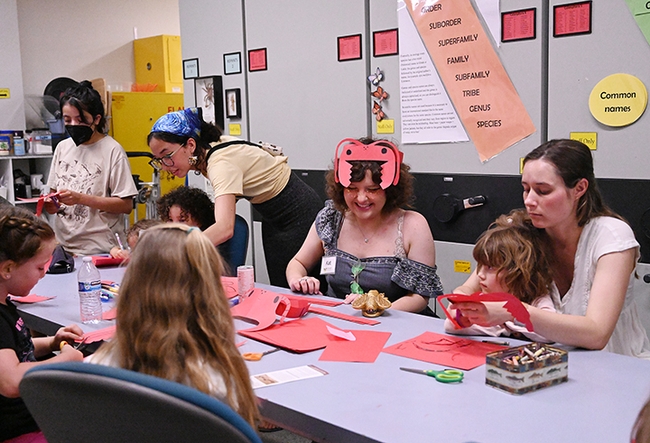
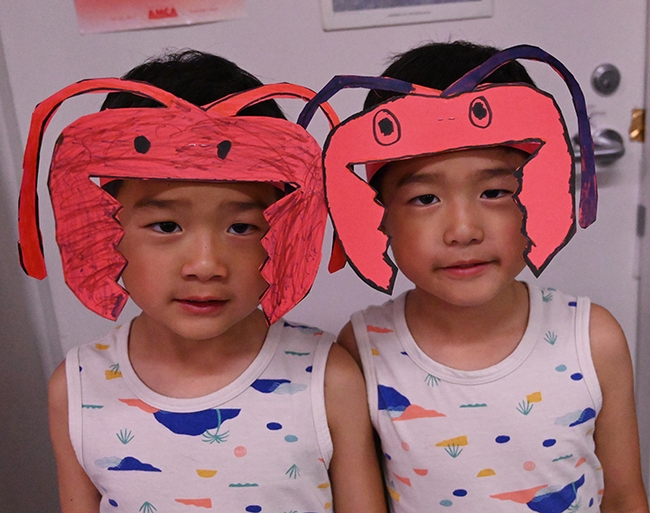
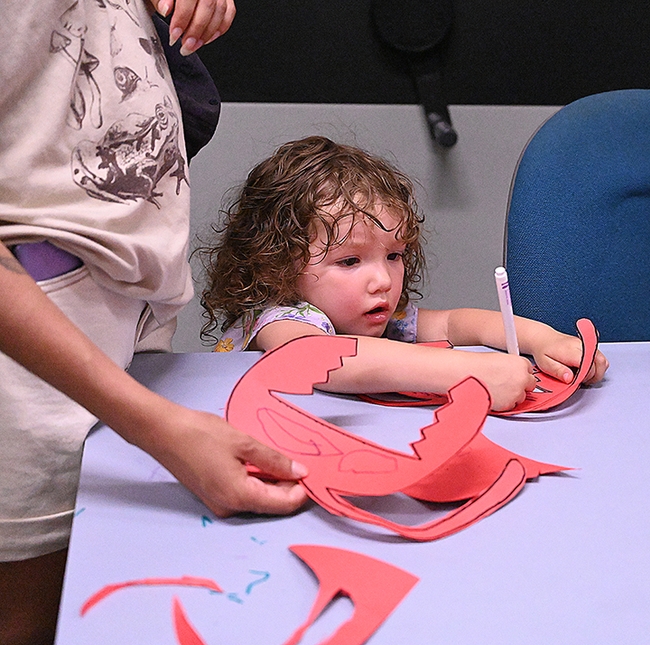
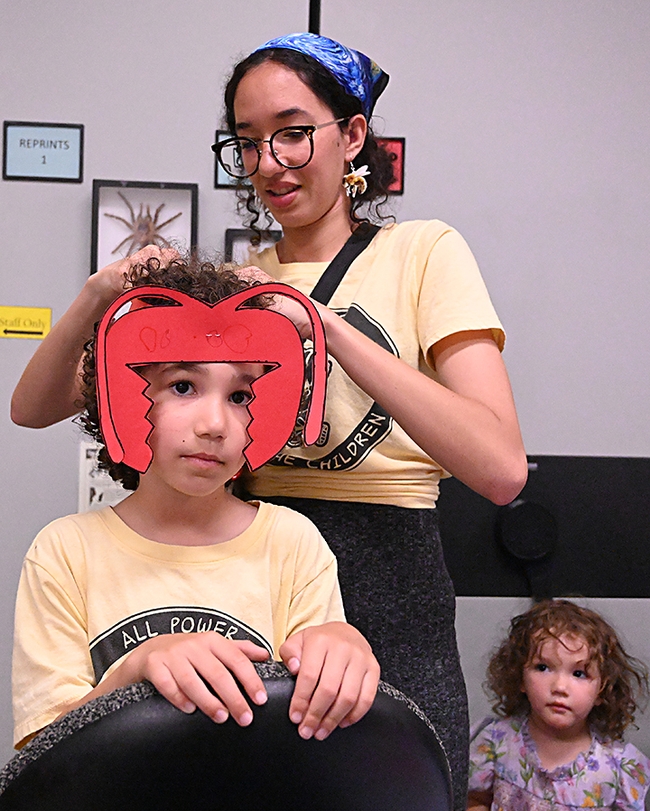
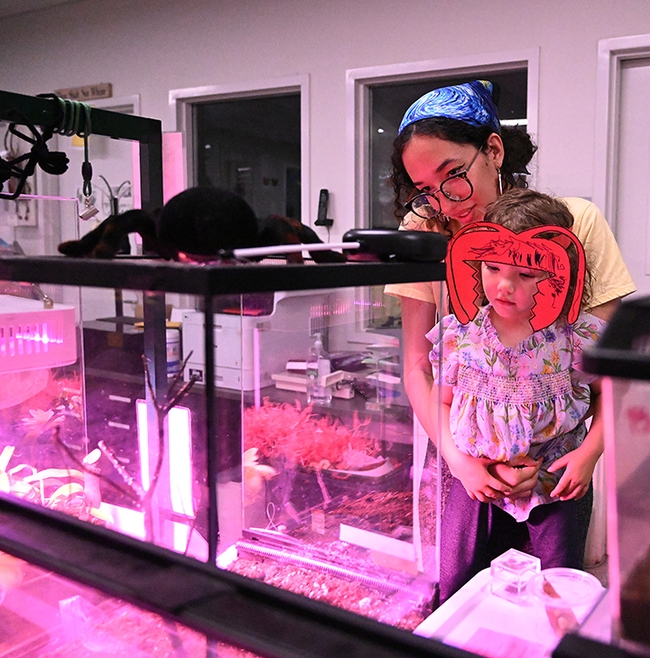
- Author: Kathy Keatley Garvey
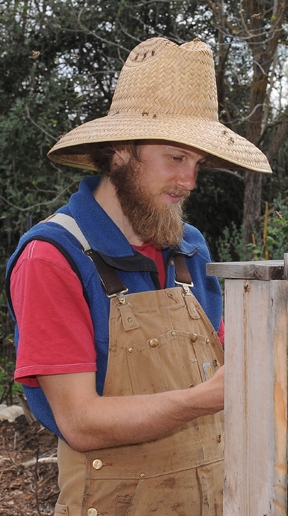
Don’t tell that to Derek Downey, who has been trying to schedule the grand opening of the Davis Bee Sanctuary now for the past two weeks.
It appears that rain is falling mainly on the Davis Bee Sanctuary.
A grand opening initially set March 21 and then changed to March 31 has now been re-scheduled for Sunday, April 1.
“It’s supposed to rain hard on Saturday, March 31, and be nice on Sunday, April 1,” said Downey, who heads the Davis Bee Collective and its newly landscaped site, the Davis Bee Sanctuary.
He’s hoping the weather will “bee nice.”
The Davis Bee Collective, a community of small-scale beekeepers founded by a former UC Davis entomology graduate student Eli Sarnat, will host the grand opening of the sanctuary from 1 to 5 p.m., Sunday, April 1 on Orchard Park Drive, near The Domes student housing. The public is invited.
The open house will be an opportunity for area residents and prospective members to “come meet the beekeepers," Downey said. The event will include tours, honey tasting, a permaculture lesson covering hugelkultur (the drought-tolerant technique being used at the sanctuary), a free flower giveaway, seed exchange (bring seeds), and a presentation on native bees, which also will be sharing the sanctuary.
A special guest speaker will be Extension apiculturist Eric Mussen of the UC Davis Department of Entomology. Also planned: a display of native bee condos from Robbin Thorp, emeritus professor of entomology at UC Davis.
As of March 29, six hives now occupy the Bee Sanctuary. "We have four empty hives and space for a total of 12," Downey said. The hives are decorated with such names as "Just Bee," "Bee Happy," "Birdhouse" and "the Whaler Superorganism."
"The bee sanctuary is also place for people to meditate, smell the flowers, watch the bees and hummingbirds in the trees, and learn about permaculture---we're using a drought-tolerant method of gardening called hugelkultur ("hoogle culture") which involves burying logs of different sizes under the soil," Downey said. "The wood breaks down and becomes a sponge able to hold on to a ton of water so that in summer months you don't need to irrigate very much, if at all!"
Sarnat established the Bee Collective in 2005. Downey, who received his bachelor's degree in engineering from UC Davis in 2009, joined the Bee Collective in 2005 and then founded a small beekeeping business, the Davis Bee Charmers in 2010 and the Davis Bee Sanctuary in 2011. As the founder of the Davis Bee Charmers, he catches swarms, relocates hives, and teaches beekeeping lessons to individuals and groups.
Downey invites interested persons to join the Bee Collective and Bee Sanctuary; information on how to join is on the Davis Wiki website at http://daviswiki.org/Davis_Bee_Collective. He moderates the Google group and adds new members. "If someone wants to just help out and learn about bees, they are always welcome to take part," he said. "We will have hives that are collectively managed so everyone can learn together. If someone wants to keep their own hive there, it is first-come, first served. We have space for 10 to 12 hives, max."
Members of the Bee Collective share resources, such as beekeeping equipment, books, and tools. Downey accepts donations for the Bee Collective and Bee Sanctuary (contact him at davisbeecharmers@gmail.com or (310) 694-2405). He recently received dozens of donated perennials.
Bee Sanctuary work parties are held every Sunday from 1 to 4 p.m. at the site.
Downey anticipates filling the other empty hives in the sanctuary via swarms he collects in Davis, Dixon, Sacramento, Woodland, and Winters.
Mmeanwhile, the Davis Bee Charmer is hoping the third time is the charm--for the weather to relent, that is.
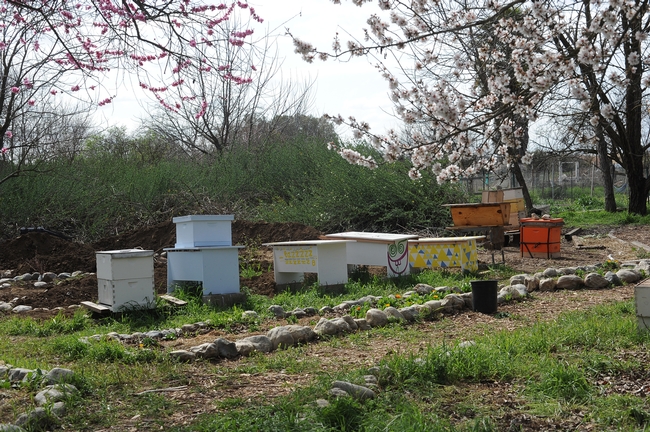
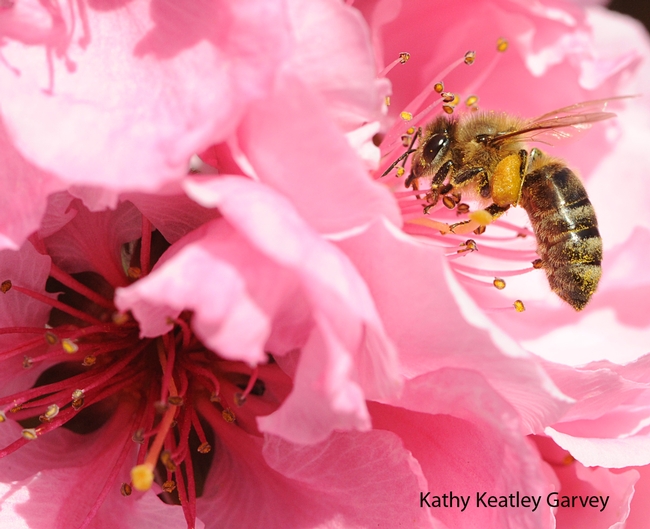
- Author: Kathy Keatley Garvey
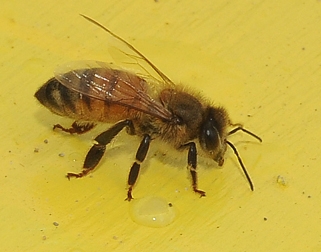
The Davis Bee Sanctuary is the place to "bee" on Saturday, March 31.
That's when the Davis Bee Collective, a community of small-scale beekeepers founded by a former UC Davis entomology graduate student, will host the grand opening of their newly landscaped apiary, aptly named the "Davis Bee Sanctuary."
The event, open to the public, is scheduled from 1 to 5 p.m. at the site on Orchard Park Drive, Davis. The main ceremony starts at 1 p.m. However, folks will be filtering in and out from 11 a.m. to 6 p.m., said Derek Downey, a seven-year beekeeper who coordinates the Davis Bee Collective and the Davis Bee Sanctuary.
Where is the Davis Bee Sanctuary? It's adjacent to the western edge of The Domes, a cooperative student housing community known for its dome-shaped structures. If you drive past The Domes on Orchard Park Drive, you'll see the Bee Sanctuary at the end of the street.
Ant specialist Eli Sarnat, who received his doctorate in entomology from UC Davis in 2009, founded the Davis Bee Collective in 2005. Now residing in Happy Camp, Siskiyou County, Sarnat is a postdoctoral researcher based at the University of Illinois, Urbana. And yes, he still keeps bees. He and a beekeeping partner maintain about 20 hives in Happy Camp.
His friend, Derek Downey, who received his bachelor's degree in engineering from UC Davis in 2009, joined the Bee Collective in 2005. Then in 2011, Downey founded The Bee Sanctuary as the place to keep the bees.
Downey owns and operates a small beekeeping business, the Davis Bee Charmers; he catches swarms, relocates hives, and teaches beekeeping lessons to individuals and groups.
Among those participating in the work parties at the Bee Sanctuary, held every Sunday from 1 to 4 p.m., are Melanie Lataste and her husband, Pierre Arrial of Nantes, France. Arrial is a postdoctoral scholar in the UC Davis Department of Geology.
What's on tap Saturday, March 31? "Come meet the beekeepers," Downey says. The event will include tours, honey tasting, a permaculture lesson covering hugelkultur (the drought-tolerant technique being used at the sanctuary), a free flower giveaway, seed exchange (bring seeds), and a presentation on native bees, which also will be sharing the sanctuary.
A special guest will be Extension apiculturist Eric Mussen of the UC Davis Department of Entomology.
Downey invites interested persons to join the Bee Collective and Bee Sanctuary; information on how to join is on the Davis Wiki website. Downey moderates the Google group and adds new members. "If someone wants to just help out and learn about bees, they are always welcome to take part," he said. "We will have hives that are collectively managed so everyone can learn together. If someone wants to keep their own hive there, it is first-come, first served. We have space for 10 to 12 hives, max."
Members of the Bee Collective share resources, such as beekeeping equipment, books, and tools. Downey accepts donations for the Bee Collective and Bee Sanctuary (email him at davisbeecharmers@gmail.com). He recently received dozens of donated perennials.
One of the hives at the sanctuary is actually a birdhouse, or what Mussen calls "a birdhouse for wood ducks." Davis homeowners "installed it to invite birds to live in it," Downey said, but a swarm of honey bees soon claimed it. So, Downey moved the birdhouse--bees and all--into the sanctuary.
Today (Tuesday, March 20) the bees in the birdhouse swarmed, as expected. They're now occupying a nearby hive in the sanctuary.
Downey anticipates filling the other empty hives soon with swarms.
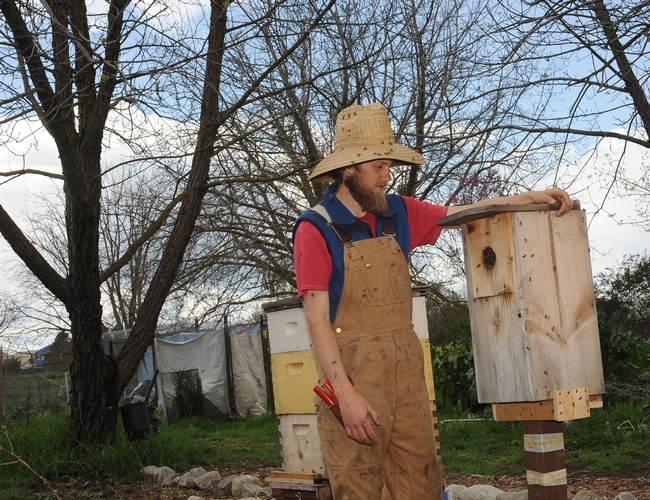
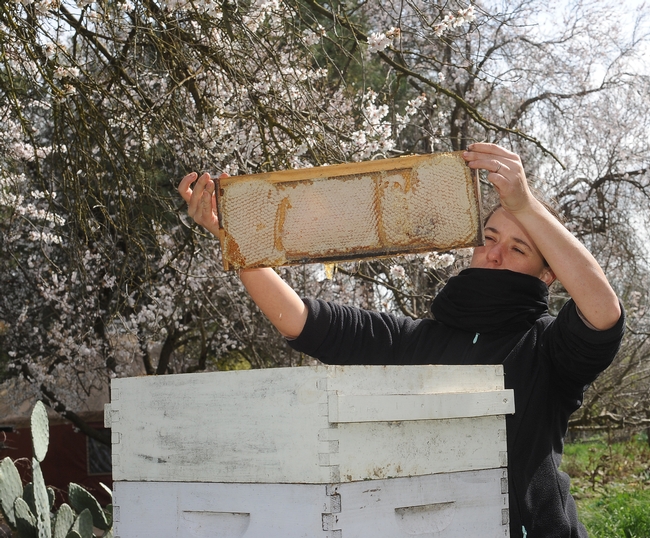
- Author: Kathy Keatley Garvey
Know your ants.
If you want to identify red imported fire ants and other invasive ants found in the
“This is one of the most clearly organized and informative sites I've ever seen,” said Lynn Kimsey, professor and chair of the UC Davis Department of Entomology and director of the Bohart Museum of Entomology. “It should be an invaluable resource for anyone needing information about pest ants in the
Invasive ants threaten the native biodiversity, food security and quality of life, said Sarnat, who is researching the systematics, biogeography and conservation of ants in
The ant key empowers professionals and non-professionals alike to identify the ants they encounter.
Sarnat compiled the guide using Lucid3 software. It covers four subfamilies, 20 genera and 44 species and includes:
- An overview of the species
- Diagnostic chart illustrating a unique combination of identification characters
- Comparison chart illustrating differences among species of similar appearance
- Video clip of the species behavior at food baits Image gallery that includes original specimen images and live images
- Nomenclature section detailing the taxonomic history of the species
- Links and references section for additional literature and online resources
The project was funded primarily by a cooperative agreement between UC Davis and the U. S. Department of Agriculture’s Center for Plant Health Science and Technology.
Sarnat became interested in invasive ants while studying at UC Berkeley. He managed the field operations for the National Science Foundation-funded Fiji Terrestrial Arthropod Survey for a year before returning to his graduate studies at UC Davis. “My experience with the arthropod survey,” he said, “prompted me to switch my thesis To raise awareness about invasive ants in the country, Sarnat conducted a series of workshops in
The
“Although the workshop participants all acknowledged the danger that ants like Solenopsis invicta (red imported fire ant) and Wasmannia auropunctata (little fire ant) posed to the environments, economies and public health of Fiji,” he said, “it was clear that none of the local entomologists or quarantine officers had the taxonomic expertise to recognize the species at ports of entry.”
With funding from
“I was contracted to develop an interactive identification guide that allowed non-specialists to accurately identify the most common and dangerous invasive ants,” Sarnat said.
The instructors provided each participant with a microscope, laptop and a CD of the new identification guide at the five-day workshop, held at the University of the Pacific in
“The workshop was a great success,” he said. “The participants felt newly empowered to prevent invasive ant incursions on their islands.”
Sarnat presented the first edition of the Pacific Invasive Ant key (PIAkey) at the 1st Pacific Invasive Ant conference in
Sarnat said the second edition represents a significant improvement over the first edition. It features fact sheets for each species, numerous specimen images and live images, videos of the ants feeding at baits, an illustrated glossary of technical terms, and an illustrated Lucid key to 44 species of invasive ants.
“Taxonomy can be a difficult field to learn because it has traditionally been taught as a body of knowledge passed down from mentors to students or through scattered and often old literature,” he said. “One must also examine specimens that exist only in a few museums across the world.”
The most exiting aspect of PIAkey, Sarnat said, is that it empowers non-specialists—those not trained by a mentor, or with no access to old literature or far-off museum collections--to use the recent technologies of digital images, the Internet, and an interactive identification software like Lucid to make accurate identifications themselves.
Last year the Bohart Museum of Entomology published a color poster of Sarnat’s auto-montages of the heads of 12 common invasive ants. The poster, “Pacific Invasive Ants,” is available at the
Further information on Sarnat’s work is on his Web site.
